GMO Labeled Food Market Size
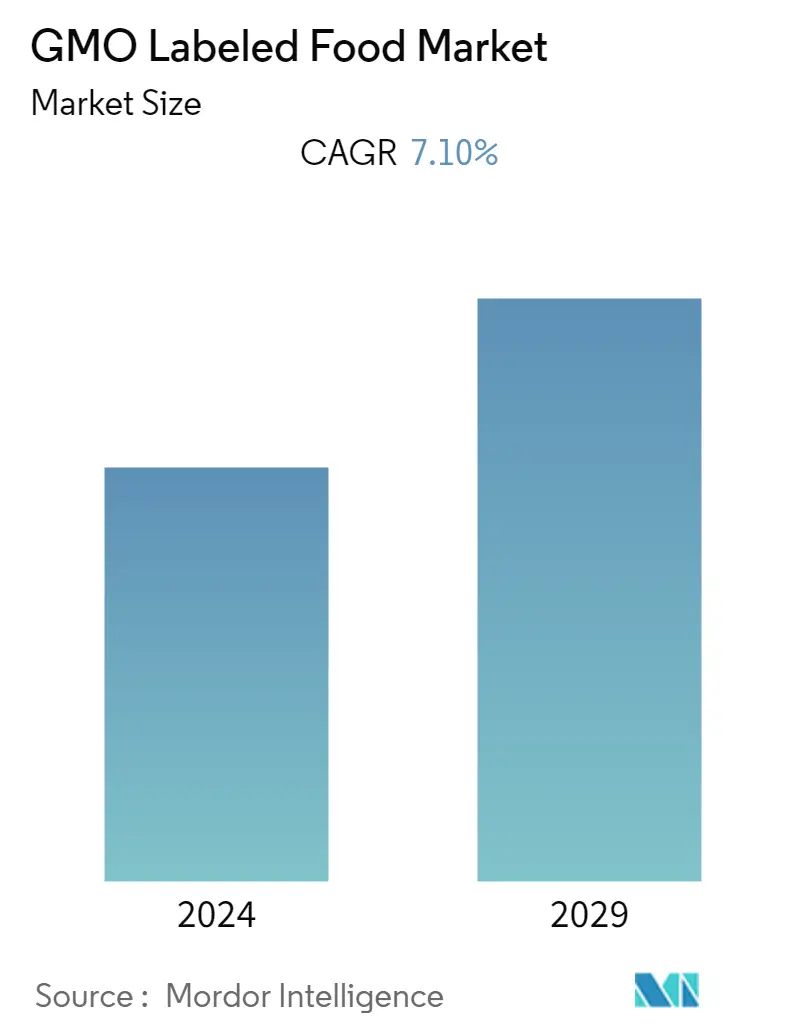
| Study Period | 2019 - 2029 |
| Base Year For Estimation | 2023 |
| CAGR | 7.10 % |
| Fastest Growing Market | Asia Pacific |
| Largest Market | Europe |
| Market Concentration | Low |
Major Players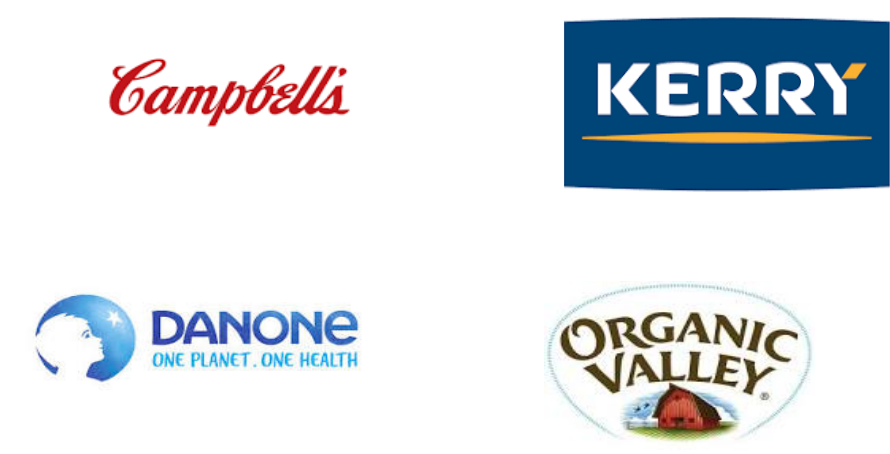
*Disclaimer: Major Players sorted in no particular order |
GMO Labeled Food Market Analysis
The GMO labeling market is expected to register a CAGR of 7.1% during the forecast period.
- With the increase in desire for clean labels and growing awareness of the ingredients used, the consumer demand for product's ingredient list, provenance, manufacturing process, shipping, storage, and safety standards, is rapidly growing.
- GMO Labeling includes origin, ingredient lists, warehouse, manufacturing process, shipping, and testing, which help the consumer to get the product they are purchasing and know what is in their food. According to a study by the Pew Research Center, 57% of Americans believe GMOs are unsafe to eat, and 67% of American support GMO labeling. This indicates that the consumers want to be informed about their product.
- Several government regulations are another driving factor behind GMO labeling. Countries like the European Union, Australia, and Japan have strict government regulations for GMO labeling. This growth in consumer awareness is immensely supported by various regulatory and non-government organizations, like Organic Consumers Association, etc., that actively create awareness and fight for the labeling rules for a product. Health and safety concern among consumers is the main factor behind GMO labeling.
GMO Labeled Food Market Trends
Growing Consumer Awareness about labelling
- There has been a rapid increase in organizations dedicated to food safety and quality and clean labels representing the aspirations and needs of society at a large scale.
- Consumers want more information about a product's constituent list, provenance, manufacturing process, transportation, storage, and safety testing regarding GMO labeling. In Canada, support for obligatory labeling of all types of GMOs is relatively consistent across demographic groupings, with just minor differences among regions, genders, and age groups.
- As customers become more concerned about healthy edible items, food manufacturers focus their efforts on GMO labeling. Consumers have a right to know whether their products contain transgenic chemicals, allowing them to make informed judgments about the risks and advantages.
- According to a survey conducted by International Food Information Council (IFIC) in 2021, approximately 51 percent of participants in the United States stated that when shopping for food or beverage products, the nutrition facts label, typically on the back or side of the product packaging, has the most significant impact on their purchasing decisions.
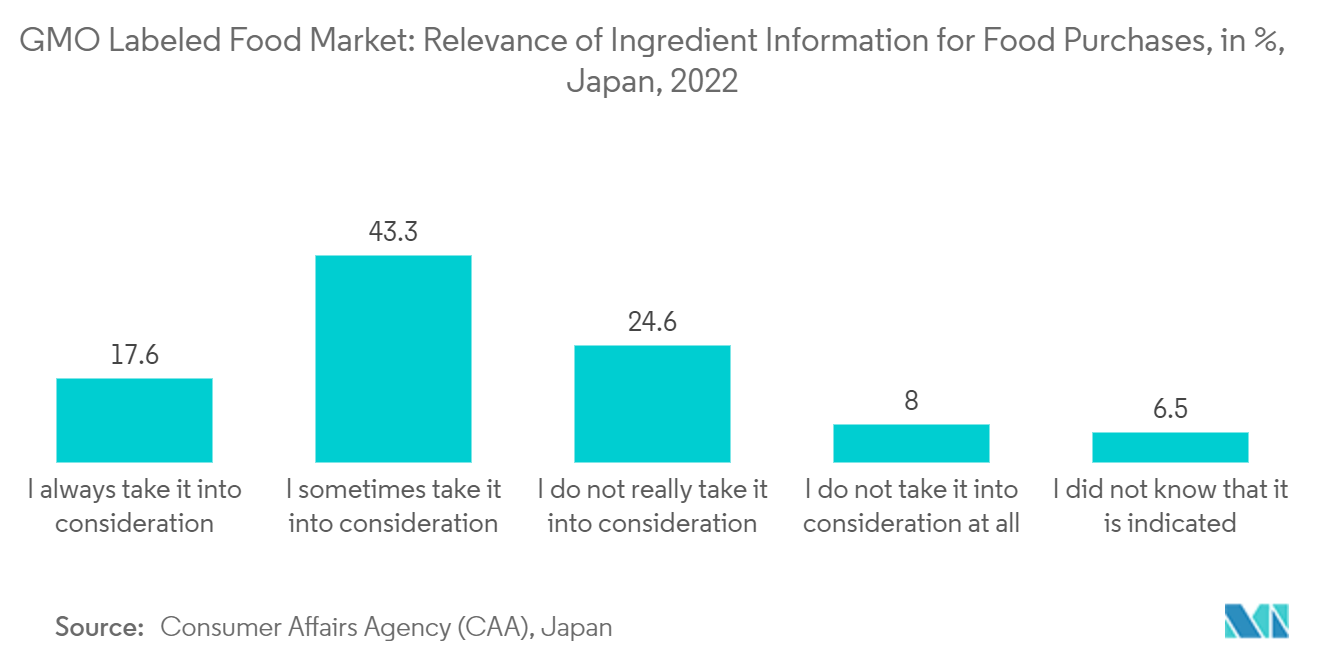
Europe hold major share in GMO Labeled Food Market
- Europe region is the most mature and developed economy. A consumer with a high income prefers health over price. Therefore, the GMO-labeled market is witnessing growth in this region. Mandatory labeling rules usually apply based on the GMO percentage of any specific ingredient in a food product. However, others apply to the complete food item. The most stringent regulations, such as those in the European Union, Saudi Arabia, Turkey, and Australia, have a 0.9% threshold.
- When surveyed by World Wide Fund for Nature (WWF) in the summer of 2022, some 30 percent of respondents in selected European Union countries mentioned that unclear labeling on food products is a factor that prevents or stops them from eating types of food that are better for the environment and are more sustainable.
- Hence, with increased consumer awareness about labeling and escalated trends of non-GMO foods, it becomes even more essential for food makers to focus their efforts on GMO labeling.
Therefore, the factors mentioned earlier are anticipated to drive the global GMO-labeled food market in the region in the coming years.
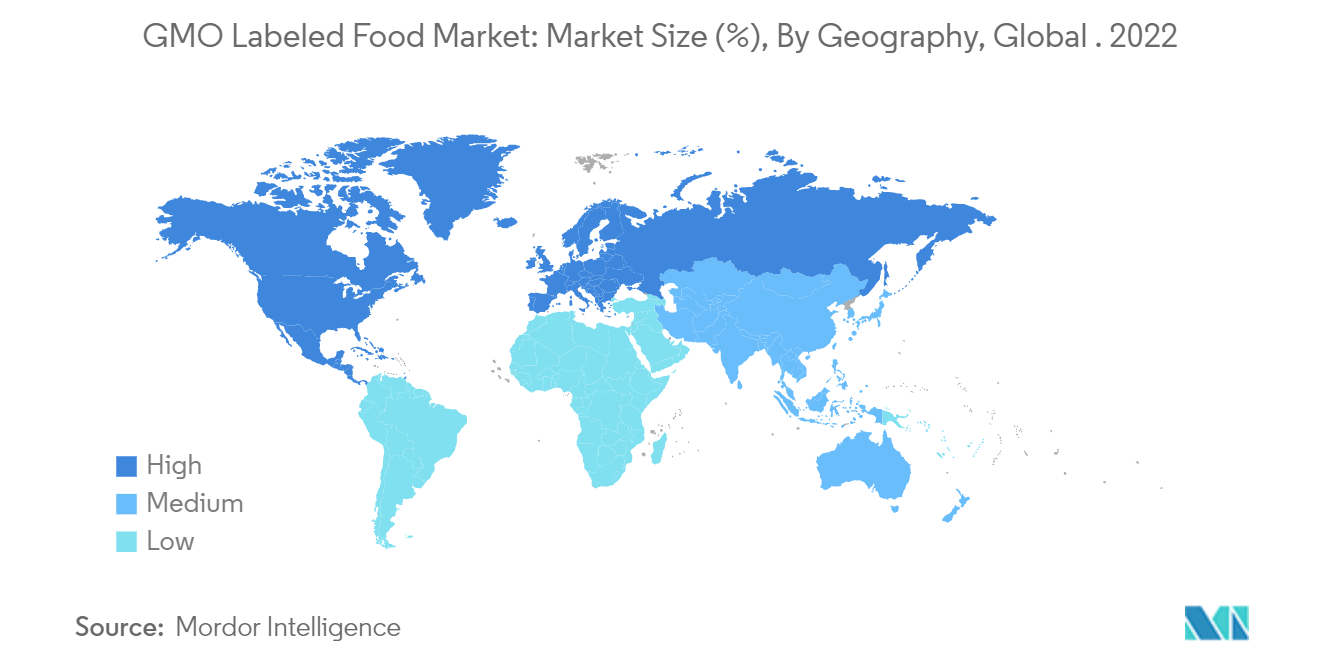
GMO Labeled Food Industry Overview
The GMO labeled food market is competitive, with the dominance of significant market players like General Mills, Campbell Soup, Danone, Kellogg Company, and ConAgra Foods Inc. The growing consumer demand for non-GMO foods has led to manufacturers launching products with GMO labeling to gain a more consumer base. Growing consumer interest in food safety has propelled high technological advancements, thereby driving the GMO-labeled food market in both developing and developed countries.
GMO Labeled Food Market Leaders
-
Campbell Soup
-
Danone
-
Kellogg Company
-
ConAgra Foods Inc.
-
General Mills
*Disclaimer: Major Players sorted in no particular order
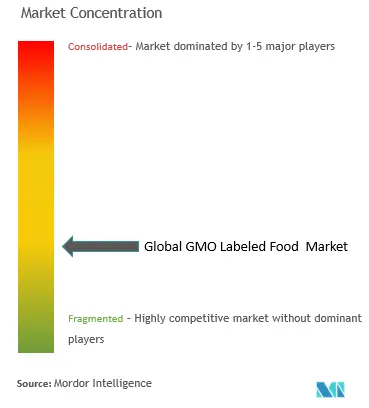
GMO Labeled Food Market News
- February 2023: Danone, a leading food and beverage company, announced it would invest up to USD 65 million over the next two years to create a new production line in Jacksonville, Florida. The investment will support Danone North America's long-term growth strategy and deliver key benefits across the U.S. business, including advancing operational excellence, accelerating the company's sustainability goals, and driving cost efficiencies.
- June 2022: Packaged food major Kellogg split into three independent companies focusing on global snacking, North American cereals, and plant-based foods.
- August 2021: Walmart launched a new line of great-value products that will provide all the products with labeled GMO or NON-GMO products new line.
GMO Labeled Food Market Report - Table of Contents
1. INTRODUCTION
- 1.1 Study Assumptions and Market Definition
- 1.2 Scope of the Study
2. RESEARCH METHODOLOGY
3. EXECUTIVE SUMMARY
4. MARKET DYNAMICS
- 4.1 Market Drivers
- 4.2 Market Restraints
-
4.3 Porter's Five Forces Analysis
- 4.3.1 Threat of New Entrants
- 4.3.2 Bargaining Power of Buyers/Consumers
- 4.3.3 Bargaining Power of Suppliers
- 4.3.4 Threat of Substitute Products
- 4.3.5 Intensity of Competitive Rivalry
5. MARKET SEGMENTATION
-
5.1 By Type
- 5.1.1 Processed Food
- 5.1.2 Meat & Poultry
- 5.1.3 Dairy
- 5.1.4 Beverage
- 5.1.5 Other Types
-
5.2 By Distribution Channel
- 5.2.1 Supermarket/Hypermarket
- 5.2.2 Convenience Stores
- 5.2.3 Specialist Stores
- 5.2.4 Online Retail Stores
- 5.2.5 Other Distribution Channels
-
5.3 Geography
- 5.3.1 North America
- 5.3.1.1 United States
- 5.3.1.2 Canada
- 5.3.1.3 Mexico
- 5.3.1.4 Rest of North America
- 5.3.2 Europe
- 5.3.2.1 United Kingdom
- 5.3.2.2 Germany
- 5.3.2.3 France
- 5.3.2.4 Russia
- 5.3.2.5 Italy
- 5.3.2.6 Spain
- 5.3.2.7 Rest of Europe
- 5.3.3 Asia Pacific
- 5.3.3.1 India
- 5.3.3.2 China
- 5.3.3.3 Japan
- 5.3.3.4 Australia
- 5.3.3.5 Rest of Asia-Pacific
- 5.3.4 South America
- 5.3.4.1 Brazil
- 5.3.4.2 Argentina
- 5.3.4.3 Rest of South America
- 5.3.5 Middle East & Africa
- 5.3.5.1 South Africa
- 5.3.5.2 United Arab of Emirates
- 5.3.5.3 Rest of Middle East & Africa
6. COMPETITIVE LANDSCAPE
- 6.1 Strategies Adopted by Leading Players
- 6.2 Market Share Analysis
-
6.3 Company Profiles
- 6.3.1 Campbell Soup
- 6.3.2 Danone
- 6.3.3 Kellogg Company
- 6.3.4 ConAgra Foods Inc.
- 6.3.5 General Mills
- 6.3.6 Chipotle
- 6.3.7 Kerry Ingredients
- 6.3.8 Organic Valley
- 6.3.9 Ingredion Incorporated
- 6.3.10 Nature's Path Foods
- *List Not Exhaustive
7. MARKET OPPORTUNITIES AND FUTURE TRENDS
** Subject To AvailablityGMO Labeled Food Industry Segmentation
GMO food labeling helps consumers make an informed choice about the food they buy by providing them with necessary information about GM ingredients on the food package.
The GMO labeled food market is segmented by type, distribution channel, and geography. Based on type, the market is segmented into processed food, meat & poultry, dairy, beverage, and others. Based on distribution channels, the market is segmented into supermarkets/hypermarkets, convenience stores, specialist stores, online retail stores, and other distribution channels. Also, the study analyzes the GMO-labeled food market in emerging and established markets worldwide, including North America, Europe, Asia-Pacific, South America, and the Middle East & Africa.
The report offers market sizes and values in (USD Million) during the forecast years for the above segments.
| By Type | Processed Food | |
| Meat & Poultry | ||
| Dairy | ||
| Beverage | ||
| Other Types | ||
| By Distribution Channel | Supermarket/Hypermarket | |
| Convenience Stores | ||
| Specialist Stores | ||
| Online Retail Stores | ||
| Other Distribution Channels | ||
| Geography | North America | United States |
| Canada | ||
| Mexico | ||
| Rest of North America | ||
| Geography | Europe | United Kingdom |
| Germany | ||
| France | ||
| Russia | ||
| Italy | ||
| Spain | ||
| Rest of Europe | ||
| Geography | Asia Pacific | India |
| China | ||
| Japan | ||
| Australia | ||
| Rest of Asia-Pacific | ||
| Geography | South America | Brazil |
| Argentina | ||
| Rest of South America | ||
| Geography | Middle East & Africa | South Africa |
| United Arab of Emirates | ||
| Rest of Middle East & Africa |
GMO Labeled Food Market Research FAQs
What is the current GMO Labeled Food Market size?
The GMO Labeled Food Market is projected to register a CAGR of 7.10% during the forecast period (2024-2029)
Who are the key players in GMO Labeled Food Market?
Campbell Soup, Danone, Kellogg Company, ConAgra Foods Inc. and General Mills are the major companies operating in the GMO Labeled Food Market.
Which is the fastest growing region in GMO Labeled Food Market?
Asia Pacific is estimated to grow at the highest CAGR over the forecast period (2024-2029).
Which region has the biggest share in GMO Labeled Food Market?
In 2024, the Europe accounts for the largest market share in GMO Labeled Food Market.
What years does this GMO Labeled Food Market cover?
The report covers the GMO Labeled Food Market historical market size for years: 2019, 2020, 2021, 2022 and 2023. The report also forecasts the GMO Labeled Food Market size for years: 2024, 2025, 2026, 2027, 2028 and 2029.
GMO Labeled Food Industry Report
Statistics for the 2024 GMO Labeled Food market share, size and revenue growth rate, created by Mordor Intelligence™ Industry Reports. GMO Labeled Food analysis includes a market forecast outlook 2029 and historical overview. Get a sample of this industry analysis as a free report PDF download.



